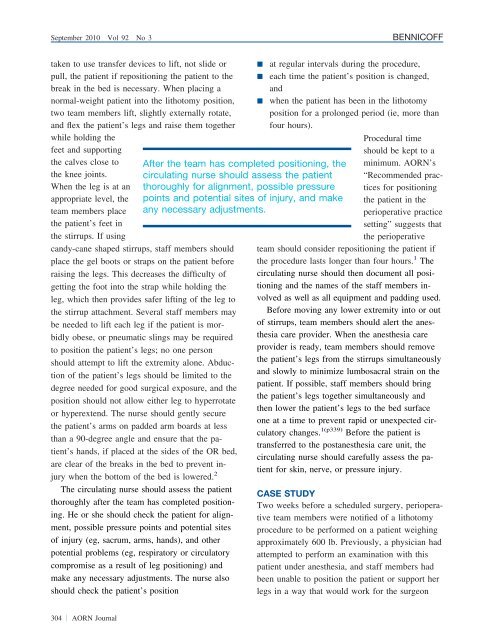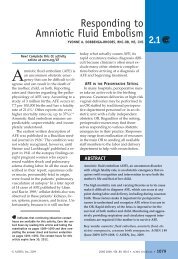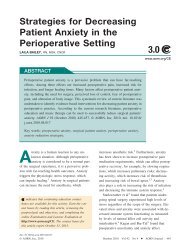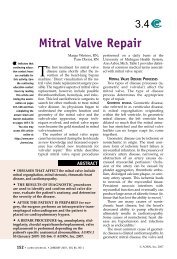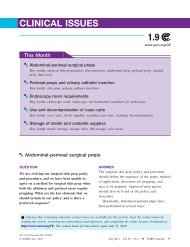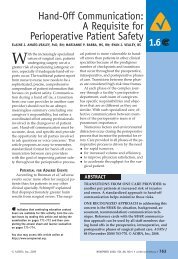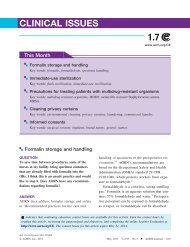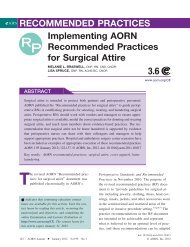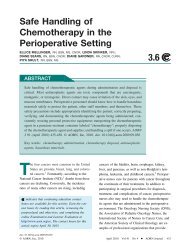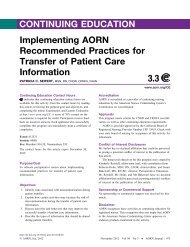Perioperative Care of the Morbidly Obese Patient in the ... - AORN
Perioperative Care of the Morbidly Obese Patient in the ... - AORN
Perioperative Care of the Morbidly Obese Patient in the ... - AORN
You also want an ePaper? Increase the reach of your titles
YUMPU automatically turns print PDFs into web optimized ePapers that Google loves.
September 2010 Vol 92 No 3 BENNICOFFtaken to use transfer devices to lift, not slide orpull, <strong>the</strong> patient if reposition<strong>in</strong>g <strong>the</strong> patient to <strong>the</strong>break <strong>in</strong> <strong>the</strong> bed is necessary. When plac<strong>in</strong>g anormal-weight patient <strong>in</strong>to <strong>the</strong> lithotomy position,two team members lift, slightly externally rotate,and flex <strong>the</strong> patient’s legs and raise <strong>the</strong>m toge<strong>the</strong>rwhile hold<strong>in</strong>g <strong>the</strong>feet and support<strong>in</strong>g<strong>the</strong> calves close to<strong>the</strong> knee jo<strong>in</strong>ts.When <strong>the</strong> leg is at anappropriate level, <strong>the</strong>team members place<strong>the</strong> patient’s feet <strong>in</strong><strong>the</strong> stirrups. If us<strong>in</strong>gcandy-cane shaped stirrups, staff members shouldplace <strong>the</strong> gel boots or straps on <strong>the</strong> patient beforerais<strong>in</strong>g <strong>the</strong> legs. This decreases <strong>the</strong> difficulty <strong>of</strong>gett<strong>in</strong>g <strong>the</strong> foot <strong>in</strong>to <strong>the</strong> strap while hold<strong>in</strong>g <strong>the</strong>leg, which <strong>the</strong>n provides safer lift<strong>in</strong>g <strong>of</strong> <strong>the</strong> leg to<strong>the</strong> stirrup attachment. Several staff members maybe needed to lift each leg if <strong>the</strong> patient is morbidlyobese, or pneumatic sl<strong>in</strong>gs may be requiredto position <strong>the</strong> patient’s legs; no one personshould attempt to lift <strong>the</strong> extremity alone. Abduction<strong>of</strong> <strong>the</strong> patient’s legs should be limited to <strong>the</strong>degree needed for good surgical exposure, and <strong>the</strong>position should not allow ei<strong>the</strong>r leg to hyperrotateor hyperextend. The nurse should gently secure<strong>the</strong> patient’s arms on padded arm boards at lessthan a 90-degree angle and ensure that <strong>the</strong> patient’shands, if placed at <strong>the</strong> sides <strong>of</strong> <strong>the</strong> OR bed,are clear <strong>of</strong> <strong>the</strong> breaks <strong>in</strong> <strong>the</strong> bed to prevent <strong>in</strong>jurywhen <strong>the</strong> bottom <strong>of</strong> <strong>the</strong> bed is lowered. 2The circulat<strong>in</strong>g nurse should assess <strong>the</strong> patientthoroughly after <strong>the</strong> team has completed position<strong>in</strong>g.He or she should check <strong>the</strong> patient for alignment,possible pressure po<strong>in</strong>ts and potential sites<strong>of</strong> <strong>in</strong>jury (eg, sacrum, arms, hands), and o<strong>the</strong>rpotential problems (eg, respiratory or circulatorycompromise as a result <strong>of</strong> leg position<strong>in</strong>g) andmake any necessary adjustments. The nurse alsoshould check <strong>the</strong> patient’s positionAfter <strong>the</strong> team has completed position<strong>in</strong>g, <strong>the</strong>circulat<strong>in</strong>g nurse should assess <strong>the</strong> patientthoroughly for alignment, possible pressurepo<strong>in</strong>ts and potential sites <strong>of</strong> <strong>in</strong>jury, and makeany necessary adjustments. at regular <strong>in</strong>tervals dur<strong>in</strong>g <strong>the</strong> procedure, each time <strong>the</strong> patient’s position is changed,and when <strong>the</strong> patient has been <strong>in</strong> <strong>the</strong> lithotomyposition for a prolonged period (ie, more thanfour hours).Procedural timeshould be kept to am<strong>in</strong>imum. <strong>AORN</strong>’s“Recommended practicesfor position<strong>in</strong>g<strong>the</strong> patient <strong>in</strong> <strong>the</strong>perioperative practicesett<strong>in</strong>g” suggests that<strong>the</strong> perioperativeteam should consider reposition<strong>in</strong>g <strong>the</strong> patient if<strong>the</strong> procedure lasts longer than four hours. 1 Thecirculat<strong>in</strong>g nurse should <strong>the</strong>n document all position<strong>in</strong>gand <strong>the</strong> names <strong>of</strong> <strong>the</strong> staff members <strong>in</strong>volvedas well as all equipment and padd<strong>in</strong>g used.Before mov<strong>in</strong>g any lower extremity <strong>in</strong>to or out<strong>of</strong> stirrups, team members should alert <strong>the</strong> anes<strong>the</strong>siacare provider. When <strong>the</strong> anes<strong>the</strong>sia careprovider is ready, team members should remove<strong>the</strong> patient’s legs from <strong>the</strong> stirrups simultaneouslyand slowly to m<strong>in</strong>imize lumbosacral stra<strong>in</strong> on <strong>the</strong>patient. If possible, staff members should br<strong>in</strong>g<strong>the</strong> patient’s legs toge<strong>the</strong>r simultaneously and<strong>the</strong>n lower <strong>the</strong> patient’s legs to <strong>the</strong> bed surfaceone at a time to prevent rapid or unexpected circulatorychanges. 1(p339) Before <strong>the</strong> patient istransferred to <strong>the</strong> postanes<strong>the</strong>sia care unit, <strong>the</strong>circulat<strong>in</strong>g nurse should carefully assess <strong>the</strong> patientfor sk<strong>in</strong>, nerve, or pressure <strong>in</strong>jury.CASE STUDYTwo weeks before a scheduled surgery, perioperativeteam members were notified <strong>of</strong> a lithotomyprocedure to be performed on a patient weigh<strong>in</strong>gapproximately 600 lb. Previously, a physician hadattempted to perform an exam<strong>in</strong>ation with thispatient under anes<strong>the</strong>sia, and staff members hadbeen unable to position <strong>the</strong> patient or support herlegs <strong>in</strong> a way that would work for <strong>the</strong> surgeon304 <strong>AORN</strong> Journal


